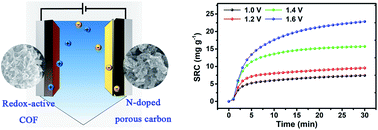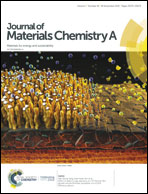Novel hybrid capacitive deionization constructed by a redox-active covalent organic framework and its derived porous carbon for highly efficient desalination†
Abstract
Capacitive deionization (CDI) is a prospective cost-efficient technology for ion removal from brackish water. The development and design of new electrode materials with reasonable structures is of special importance for high-performance CDI. Herein, a redox-active covalent organic framework (COF) was first introduced and demonstrated as a novel faradaic cathode material for hybrid CDI (HCDI) applications. Due to the high specific surface area and orderly distribution of the redox unit, COF presented high capacitance of 170.9 F g−1 and typical pseudocapacitive characteristics. Moreover, an N-doped porous carbon with a high surface area and interconnected nanopores was synthesized from the same COF and used as the anode in HCDI. The HCDI system demonstrated the highest salt removal capacity of 22.8 mg g−1 along with a maximum desalination rate of 3.2 mg g−1 s−1 in a 500 ppm NaCl solution. The strategy used in this work should provide a new insight in exploring high-performance electrode materials for desalination applications.



 Please wait while we load your content...
Please wait while we load your content...